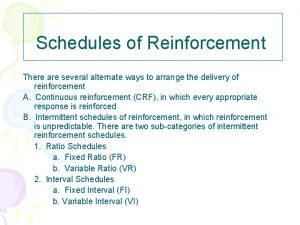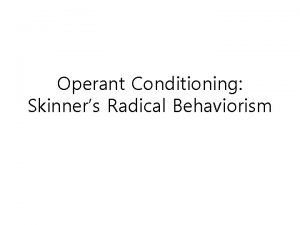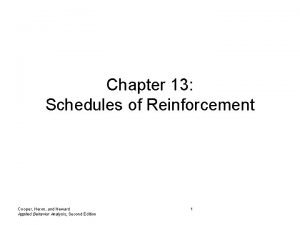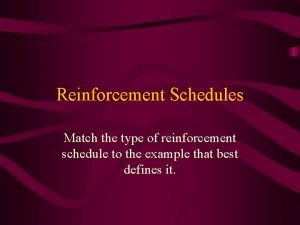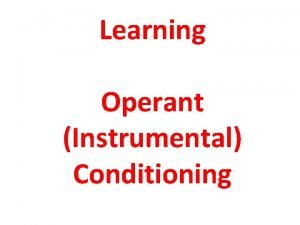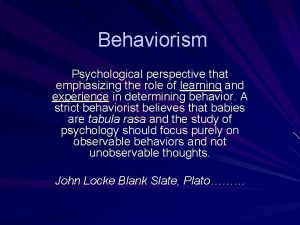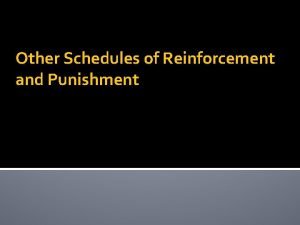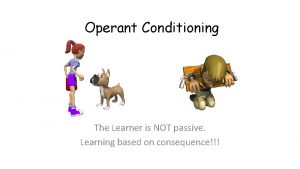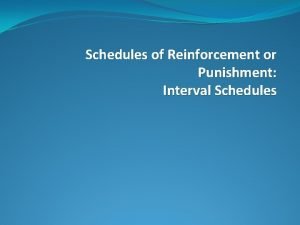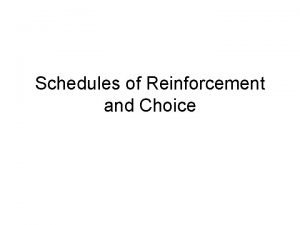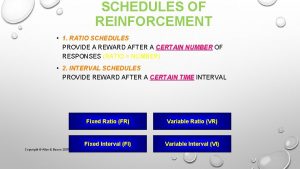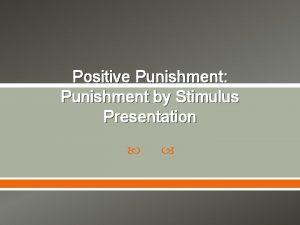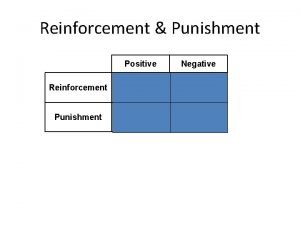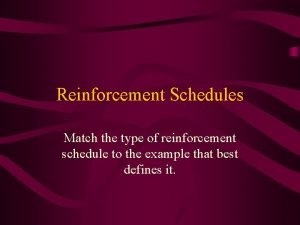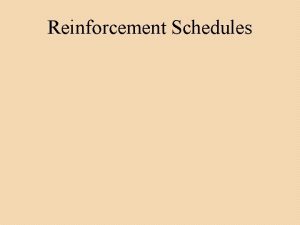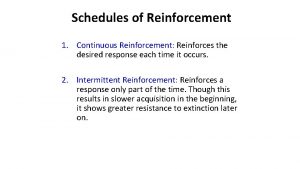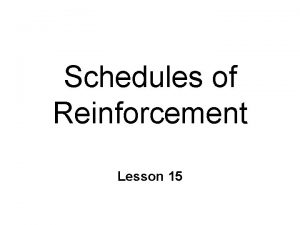Schedules of Reinforcement or Punishment Ratio Schedules Schedules















- Slides: 15

Schedules of Reinforcement or Punishment: Ratio Schedules

Schedules of Reinforcement • Many different types o Continuous Reinforcement (CRF) o Response Schedules (Ratio) o Time Schedules (Interval) o Differentiation Schedules

Continuous Schedules o Uses reinforcement or punishment procedures o Give a reinforcer or punisher for every occurrence of a behavior o Usually used in a shaping program o Get rapid and high rates of responding o Problem - Get rapid extinction once the stimulus is removed

Other issues o Get satiation if you provide to many reinforcers o May get emotional responses when providing punishers o Advantageous for skill acquisition

Ratio Schedules • Based on responses • Are different than time (interval) schedules • Require a specific number of correct responses before one response produces reinforcement • Two major types o Fixed o Variable

Fixed Ratio (FR) Schedules • The number of responses required before reinforcement is given remains constant. o FR-2 Reinforcement is delivered after every 2 nd correct response. o FR-4 Reinforcement is delivered after every 4 th correct response. o FR-1 = Continuous Schedule • Produce high rates of responding • Larger the ratio requirement, the higher the rate of responding.

Some Issues • Often get a post reinforcement (preratio) pause following the deliver of the reinforcer • Pauses occur throughout the session • Pauses are longer later in the session o Lots of reasons Habituation, Satiation, Sensitization (see Mc. Sweeney) • Pauses are often correlated with the amount or size of the reinforcer

Characteristics • Gives high rates of responding • More resistant to extinction than continuous schedules • May begin to thin the schedule (responses required between reinforcers) when used in applied settings o No more than 30% o May get Ratio Strain when you make the schedule to long (thin) between reinforcers

Fixed Ratio (FR) Schedule. A = Post reinforcement pause Responses B B = High rate of response “run” A C = reinforcer delivered upon emission of nth response C Time

Variable Ratio (VR) Schedules • The response requirement changes from one reinforced response to another. o Variable Ratio – 4 (VR 4). Reinforcement is given on an average of every 4 th correct responses o Variable Ratio - 20 (VR-20). Reinforcement is given on an average of every 20 correct responses

Variable Ratio (VR) Schedule. Responses A = High steady rate of responding B = Reinforcement delivered after a varying number of required responses are emitted A Schedule Effects: B Time Ratio requirements are completed with a very high rate of response and little hesitation between responses. Postreinforcement pauses are not a characteristic of the VR schedule. Rate of response is influenced by the size of the ratio requirements

Characteristics • Tends to produce a high and steady rates of responding. • Generally, the larger the ratio requirement, the quicker the rate of response. o Have to increase gradually. • Tends to not produce post-reinforcement pauses. • Very resistant to extinction.

Some Issues • Cannot thin the schedule rapidly • Need to be careful when using within industrial settings. • Can be used to understand a large number of behaviors o Crying at night o Disruptive behavior in classrooms

Final Notes • Minimal schedule differences between reinforcement and punishment • Major differences in applications within applied settings o Want minimal time between the response and punishment, o May allow other reinforcement schedules to take control o Review the Azrin and Holz, Campbell and Church, Van Houten materials when using punishing stimuli.

Conclusions • Ratio Schedules can be highly effective to increase or decrease behavior. • Industrial settings: Is not liked by groups that focus on trying to decrease worker productivity. • Need to be careful to increase demands of responding slowly • Can be used on most behaviors
 What is a reinforcement schedule
What is a reinforcement schedule Partial reinforcement ap psychology definition
Partial reinforcement ap psychology definition Radical behaviorism
Radical behaviorism Concurrent schedule of reinforcement
Concurrent schedule of reinforcement Best schedule of reinforcement
Best schedule of reinforcement Variable reinforcement schedule
Variable reinforcement schedule Fixed ratio reinforcement example
Fixed ratio reinforcement example Acquiring experience
Acquiring experience Variable interval
Variable interval Instinctive drift psychology definition
Instinctive drift psychology definition Types of reinforcement schedules
Types of reinforcement schedules Operant vs classical conditioning
Operant vs classical conditioning Reinforcement schedule types
Reinforcement schedule types Differential reinforcement schedules
Differential reinforcement schedules Classical and operant conditioning are forms of
Classical and operant conditioning are forms of Positive reinforcement psychology definition
Positive reinforcement psychology definition
